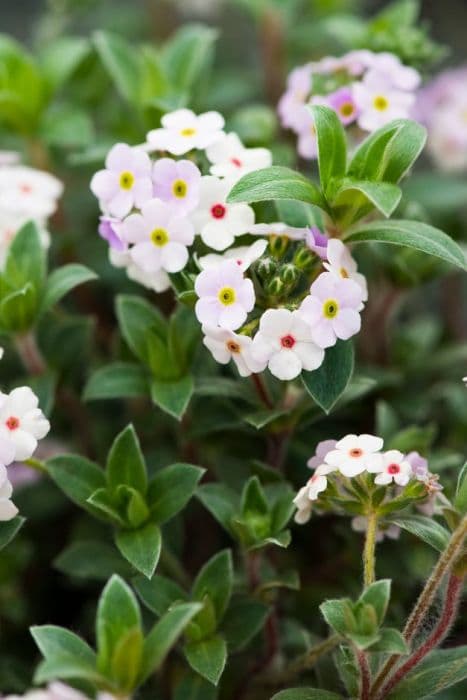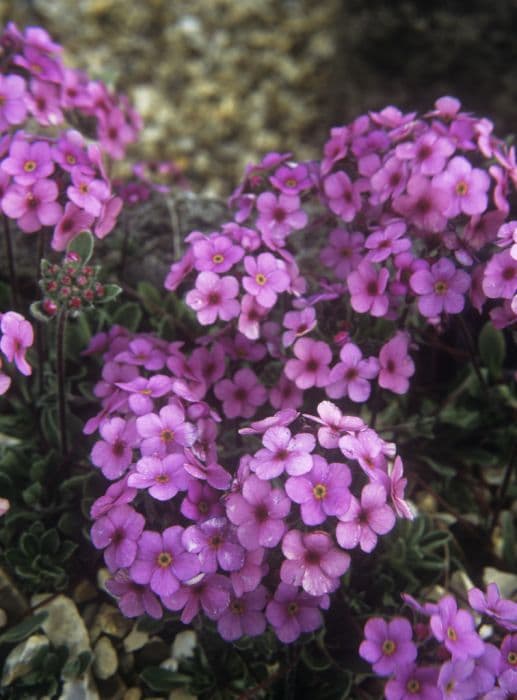Cyclamen 'Halios Violet' Cyclamen persicum 'Halios Violet'

ABOUT
'Halios Violet' is a tuberous perennial to 30cm, with marbled foliage and light purple flowers with a red-purple mouth
About this plant
 Names
NamesFamily
Primulaceae
Synonyms
Persian Cyclamen, Florist's Cyclamen
Common names
Cyclamen persicum 'Halios Violet'.
 Characteristics
CharacteristicsLife cycle
Perennials
Foliage type
Evergreen
Color of leaves
Mixed
Flower color
Violet
Height
6 inches [15 cm]
Spread
6 inches [15 cm]
Plant type
Bulb
Hardiness zones
9
Native area
Middle East
Benefits
 General Benefits
General Benefits- Decorative Appeal: Cyclamen persicum 'Halios Violet' has vibrant violet flowers, adding color and elegance to home decor or gardens.
- Seasonal Interest: Its blooming season is typically during the winter months, bringing color to the garden when most other plants are dormant.
- Compact Size: The plant remains relatively small, making it suitable for windowsills, tabletops, and small outdoor spaces.
- Long Blooming Period: Cyclamen persicum 'Halios Violet' provides a long-lasting display of flowers, often blooming for several months.
- Attracts Pollinators: When planted outside, it can attract bees and butterflies, contributing to the health of the local ecosystem.
- Gift Plant: Its attractive appearance and seasonal blooming make it a popular gift, especially during the holiday season.
- Easy to Propagate: Cyclamen persicum 'Halios Violet' can be propagated by seed or division, allowing gardeners to create more plants.
- Drought Tolerant: Once established, it has a degree of drought tolerance, reducing the need for frequent watering.
 Medical Properties
Medical PropertiesThis plant is not used for medical purposes.
 Air-purifying Qualities
Air-purifying QualitiesThis plant is not specifically known for air purifying qualities.
 Other Uses
Other Uses- As a natural dye: The intense pigmentation of Cyclamen persicum flowers can be used to create a natural dye for fabric or paper crafting.
- Decorative motifs: The intricate patterns of the Cyclamen's leaves and the vibrant flowers can inspire designs for textiles, wallpaper, or other decorative arts.
- Educational model: Cyclamen persicum's unique flower structure can be used in botanical studies to illustrate plant reproductive parts to students.
- Photography subject: Cyclamen's striking appearance makes it a popular subject for botanical photography and photo competitions.
- Festive decor: Potted Cyclamen plants can be incorporated into holiday decor, especially for their bright colors around winter celebrations.
- Children’s gardens: Due to its non-toxic nature, the Cyclamen can be safely included in gardens designed for educational purposes in schools and kindergartens.
- Theme gardens: Cyclamen can be featured in theme gardens that showcase plants from the Mediterranean or plants with heart-shaped leaves.
- Color contrast in landscaping: Cyclamen's violet flowers can be planted to provide striking color contrast in garden beds and borders.
- Companion planting: Cyclamen can be used in companion planting to complement autumn-flowering plants and extend the garden's flowering season into early winter.
- Mood elevation: The vibrant colors and elegant shape of Cyclamen flowers can help lift spirits and are often used in horticultural therapy settings to promote well-being.
Interesting Facts
 Feng Shui
Feng ShuiCyclamen is not used in Feng Shui practice.
 Zodiac Sign Compitability
Zodiac Sign CompitabilityCyclamen is not used in astrology practice.
 Plant Symbolism
Plant Symbolism- Deep Love: Cyclamen, also known as Persian Violet, is often associated with deep love due to its heart-shaped leaves and vibrant flowers, representing strong emotions and affectionate bonds.
- Sincerity: It symbolizes sincere feelings, as giving cyclamen is considered a gesture of genuine fondness and honesty in relationships.
- Goodbye: Because the cyclamen's life cycle involves the plant going dormant, it is sometimes used to represent a parting or an end, signaling a thoughtful farewell.
- Resilience: Persian Violets are hardy plants that can thrive in tough environments, which makes them a symbol for resilience and the ability to overcome difficult situations.
- Maternal Love: In some cultures, the cyclamen plant is a symbol of a mother’s undying love, reflecting the nurturing and protective nature of mothers.
 Water
WaterCyclamen requires attentive watering practices to thrive. It's best to let the top inch of soil slightly dry out between watering. In general, water Cyclamen every 7 to 10 days with enough water to moisten the soil thoroughly, typically about 8-16 ounces, depending on pot size. However, you should adjust the frequency based on humidity, temperature, and light levels, as these factors can alter a plant's water needs. Avoid watering directly onto the leaves or flowers; water the soil instead to prevent rot and fungal diseases.
 Light
LightCyclamen prefer bright, indirect light when grown indoors. Direct sunlight can scorch their leaves, while too little light will cause them to grow leggy. A north or east-facing window is an ideal spot for Cyclamen, providing the gentle light they need without the harsh midday sun. Ensure the plant is not subjected to drafts or heat sources that might stress it.
 Temperature
TemperatureCyclamen thrive in cooler temperatures and should be kept in an environment between 50°F and 68°F for optimal growth. They can survive temporarily in temperatures as low as 40°F and as high as 72°F, but these are not ideal conditions. For best results, maintain a steady temperature within the preferred range, avoiding sudden drops or spikes that could stress the plant.
 Pruning
PruningPruning Cyclamen mainly involves the removal of yellowing or dead leaves and spent flowers to encourage healthy growth and more blooms. This should be done as needed throughout the growing season. The best time to prune is immediately after the flowers fade, gently twisting off the spent blooms and leaves without damaging the tuber. Regular removal of dying foliage helps prevent disease and allows the plant to direct energy to new growth.
 Cleaning
CleaningAs needed
 Soil
SoilThe Persian cyclamen, including 'Halios Violet', thrives in well-draining, loose soil with a peat-based potting mix, or a combination of equal parts peat, loam, and sand. Maintain a slightly acidic to neutral pH between 6.5 and 7.0 for optimal growth.
 Repotting
RepottingPersian cyclamens like 'Halios Violet' generally require repotting every one to two years, best done when the plant is dormant, typically in late summer after the foliage has died down.
 Humidity & Misting
Humidity & MistingPersian cyclamen prefers high humidity but not wet leaves. Aim for about 50% relative humidity. Provide humidity with a pebble tray or humidifier, but avoid misting to prevent crown rot.
 Suitable locations
Suitable locationsIndoor
Keep Persian cyclamen in bright, indirect light, cool temps, and high humidity.
Outdoor
Plant in dappled shade, shelter from intense sun and rain.
Hardiness zone
9-11 USDA.
 Life cycle
Life cycleThe life cycle of the Florist's Cyclamen ('Halios Violet' variety) begins with seed germination, which occurs in a moist, well-drained medium under dappled light. The seeds develop into small tubers, from which sprout heart-shaped leaves and eventually, the characteristic violet flowers. After blooming, pollination must occur for seed production, often facilitated by insects. Once the flowers wither, the plant goes into a period of dormancy, especially in hot summers or cold winters, where the foliage dies back and the tuber rests. As temperatures become favorable again, the tuber breaks dormancy, sprouting new foliage, and the cycle recommences. Proper care during the growth, dormancy, and reblooming stages ensures the plant’s longevity and vitality.
 Propogation
PropogationPropogation time
Late winter-early spring
Propogation: The Cyclamen, specifically the Cyclamen persicum 'Halios Violet', is commonly propagated through seed sowing. The best time for this is usually late winter to early spring. To propagate, Cyclamen seeds require a period of cold stratification to break dormancy, followed by sowing in a well-draining soil mix. The seeds should be placed on the surface of the soil and lightly covered with a thin layer of soil or perlite, and then kept consistently moist at a temperature of 60 to 65 degrees Fahrenheit (15.6 to 18.3 degrees Celsius). Seedlings can take several weeks to germinate and once they sprout, they should be grown in cooler conditions with bright, indirect light until they are large enough to handle, at which point they can be transplanted into individual pots. This slow and meticulous process requires patience, as it can take up to a year or more for the plants to flower.









